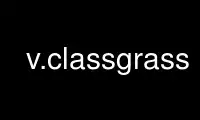
This is the command v.classgrass that can be run in the OnWorks free hosting provider using one of our multiple free online workstations such as Ubuntu Online, Fedora Online, Windows online emulator or MAC OS online emulator
PROGRAM:
NAME
v.class - Classifies attribute data, e.g. for thematic mapping
KEYWORDS
vector, classification, attribute table, statistics
SYNOPSIS
v.class
v.class --help
v.class [-g] map=name [layer=string] column=name [where=sql_query] algorithm=string
nbclasses=integer [--help] [--verbose] [--quiet] [--ui]
Flags:
-g
Print only class breaks (without min and max)
--help
Print usage summary
--verbose
Verbose module output
--quiet
Quiet module output
--ui
Force launching GUI dialog
Parameters:
map=name [required]
Name of vector map
Or data source for direct OGR access
layer=string
Layer number or name
Vector features can have category values in different layers. This number determines
which layer to use. When used with direct OGR access this is the layer name.
Default: 1
column=name [required]
Column name or expression
where=sql_query
WHERE conditions of SQL statement without ’where’ keyword
Example: income < 1000 and inhab >= 10000
algorithm=string [required]
Algorithm to use for classification
Options: int, std, qua, equ, dis
int: simple intervals
std: standard deviations
qua: quantiles
equ: equiprobable (normal distribution)
nbclasses=integer [required]
Number of classes to define
DESCRIPTION
v.class classifies vector attribute data into classes, for example for thematic mapping.
Classification can be on a column or on an expression including several columns, all in
the table linked to the vector map. The user indicates the number of classes desired and
the algorithm to use for classification. Several algorithms are implemented for
classification: equal interval, standard deviation, quantiles, equal probabilities, and a
discontinuities algorithm developed by Jean-Pierre Grimmeau at the Free University of
Brussels (ULB). It can be used to pipe class breaks into thematic mapping modules such as
d.vect.thematic (see example below);
NOTES
The equal interval algorithm simply divides the range max-min by the number of breaks to
determine the interval between class breaks.
The quantiles algorithm creates classes which all contain approximately the same number of
observations.
The standard deviations algorithm creates class breaks which are a combination of the mean
+/- the standard deviation. It calculates a scale factor (<1) by which to multiply the
standard deviation in order for all of the class breaks to fall into the range min-max of
the data values.
The equiprobabilites algorithm creates classes that would be equiprobable if the
distribution was normal. If some of the class breaks fall outside the range min-max of the
data values, the algorithm prints a warning and reduces the number of breaks, but the
probabilities used are those of the number of breaks asked for.
The discont algorithm systematically searches discontinuities in the slope of the
cumulated frequencies curve, by approximating this curve through straight line segments
whose vertices define the class breaks. The first approximation is a straight line which
links the two end nodes of the curve. This line is then replaced by a two-segmented
polyline whose central node is the point on the curve which is farthest from the preceding
straight line. The point on the curve furthest from this new polyline is then chosen as a
new node to create break up one of the two preceding segments, and so forth. The problem
of the difference in terms of units between the two axes is solved by rescaling both
amplitudes to an interval between 0 and 1. In the original algorithm, the process is
stopped when the difference between the slopes of the two new segments is no longer
significant (alpha = 0.05). As the slope is the ratio between the frequency and the
amplitude of the corresponding interval, i.e. its density, this effectively tests whether
the frequencies of the two newly proposed classes are different from those obtained by
simply distributing the sum of their frequencies amongst them in proportion to the class
amplitudes. In the GRASS implementation, the algorithm continues, but a warning is
printed.
EXAMPLE
Classify column pop of map communes into 5 classes using quantiles:
v.class map=communes column=pop algo=qua nbclasses=5
This example uses population and area to calculate a population density and to determine
the density classes:
v.class map=communes column=pop/area algo=std nbclasses=5
The following example uses the output of d.class and feeds it directly into
d.vect.thematic:
d.vect.thematic -l map=communes2 column=pop/area \
breaks=`v.class -g map=communes2 column=pop/area algo=std nbcla=5` \
colors=0:0:255,50:100:255,255:100:50,255:0:0,156:0:0
Use v.classgrass online using onworks.net services
